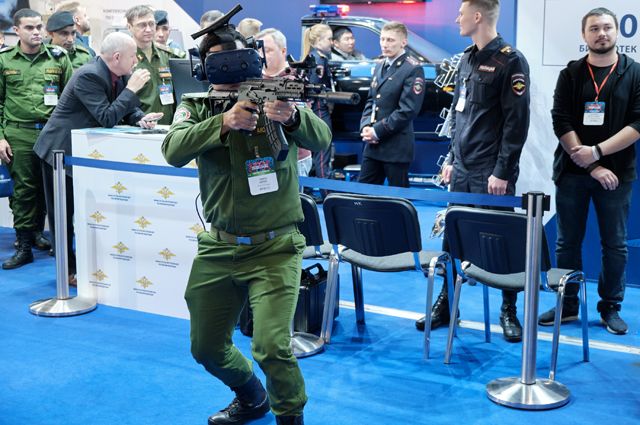
The Moscow design office presented a working prototype of virtual reality glasses called Rebel. They are intended to be used to train equipment control skills, first of all, on aviation simulators, as well as training for actions in combat conditions. This is a fully Russian development. & Nbsp;
The 'Rebel' virtual reality headset developed in Russia may become in demand among the military. It is no coincidence that it was first shown at the Army Forum in a dark green color scheme. Granted, this gadget could face the fate of another VR headset, Svarog, whose testing began in 2016. Next, the developer, the National Robotics Research Institute of the Ministry of Defense of the Russian Federation, said the new device would allow the UAV operator to not only see the battlefield from the device's cameras, but also control it with a simple turn head and direction of gaze. Recently, however, nothing has been reported on this development.
Rebel prototype attached to the back of the head with a special strap. The glasses have two LCD screens inside with a resolution of 4860 by 2520 and the ability to see at 140 degrees. Our own patented short throw lenses were created for optics. It has additional sensors to follow the direction of the gaze with automatic adjustment of the lens according to the interpupillary distance. It is worth noting that the headset is compatible with Russian and foreign operating systems & mdash; Astra Linux and Windows. & Nbsp;
The shallow depth of the front of the case is particularly interesting from a technical point of view. The final version should only be 30 millimeters deep. The Oculus Quest 2 (one of the most popular headsets today) has a depth of around 70 millimeters. The smaller the glasses, the less pressure on the bridge of the nose and other parts of the face, and the more comfortable active actions such as head turns.
Rebel & mdash; this is a completely russian development, including hardware, software and a laser positioning system. Certainly, the manufacture of some electronic components was commissioned from abroad, but for advanced devices, even for military purposes, this is a normal process, as it is impossible to do so. To establish a complete production cycle in the territory of a country. But the whole process from design to assembly was carried out by national engineers.
The primary consumers of the novelty can be both military and government customers. The company agrees that the military are very likely to become customers of novelty, as well as representatives of large companies. The price for the instance has yet to be announced. & Nbsp;
In 2017, it was reported that the virtual reality and augmented reality platform is expected to be implemented in combat training centers and technical training aid packages for military units. . This meant the development of new simulators and the modernization of existing simulators, connection to the control systems of combat training centers, laser systems to simulate fire and destruction. It is assumed that the introduction of modern technologies in combat training will lead to a reduction in the time required to train the military to perform the planned tasks through the use of modern training methods, and a reduction in the cost of combat training by saving fuel and lubricants and ammunition.
This technology is very promising and is of interest to the main computer manufacturers. Apple is known to be brewing its own VR headset with features that no other virtual or augmented reality device on the market yet has. The company plans to equip the glasses with two 8K screens and around ten cameras. It will probably work for the military as well.

